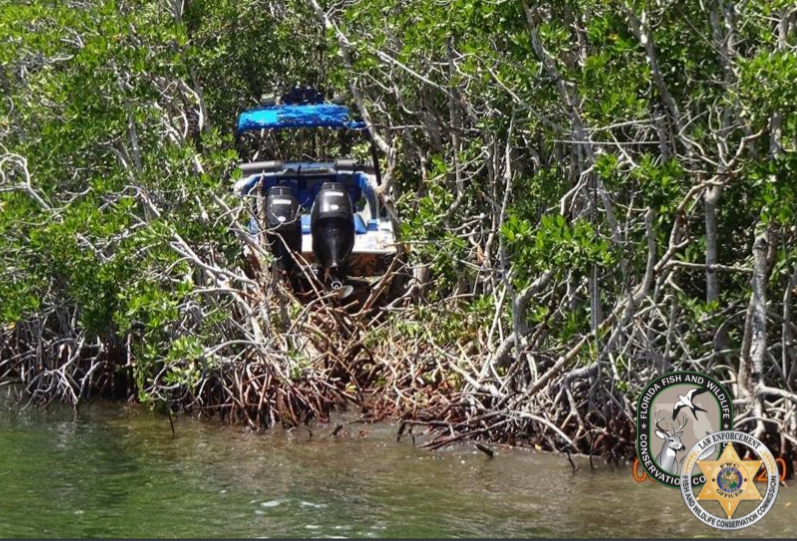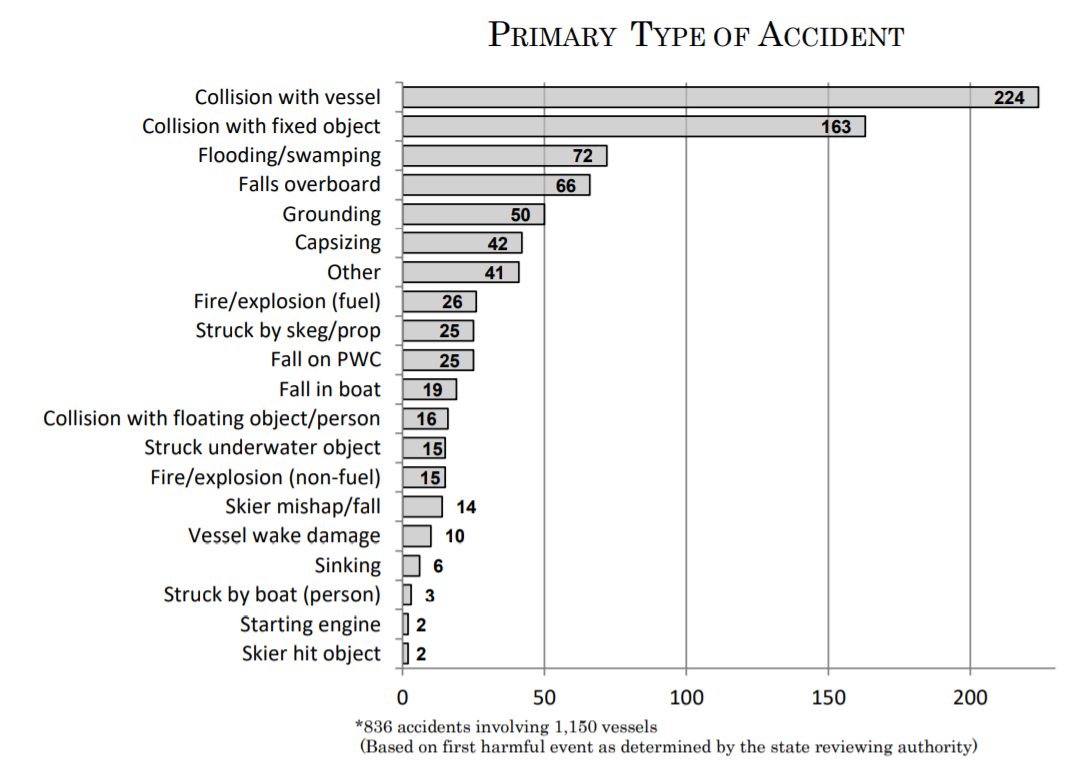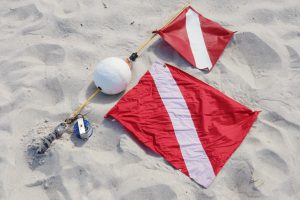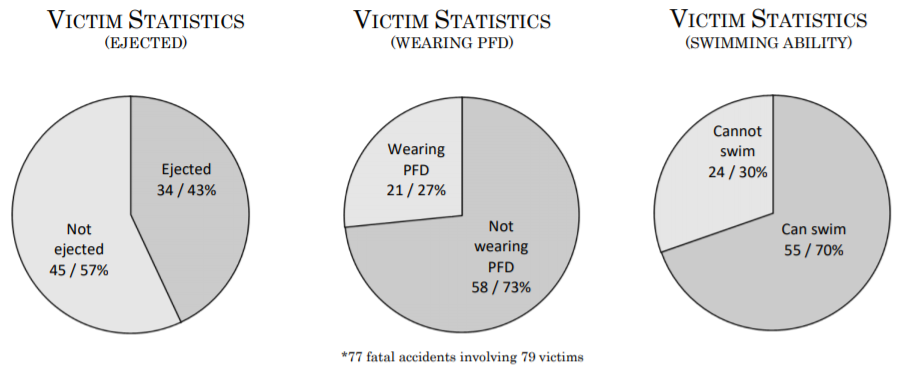Florida leads the nation with many impressive statistics such as having the most IGFA fishing world records (925), being the state with most amount of coastline in the lower 48 (1,350 miles) and having more boats registered here than any other state (954,731 recreational and 30,274 commercial registered vessels)! With almost half of the 836 reported 2020 accidents happening between the months of May-August. This is a great time to brush up on some safety information as you approach the water’s edge!
Did you know that anyone born after January 1, 1988 who operates an engine of 10 horsepower or more needs to complete an approved boating safety course and obtain a Florida Boater Safety Card? Most online courses are very affordable ($15.00-$50.00) with Boat US course being completely FREE! Regardless of age, everyone should check them out as 58% of boat operators involved in accidents were over the age of 36 and 53% of total operators did not have boater education. For more Boating Safety ID Card information check out this page, for a list of approved courses check here.
Time of year and day

To some, checking out the frequency of accidents and observing trends among seasons is no surprise, as the weather heats up and people head to the water to cool off but there are additional factors that may contribute that boaters and swimmers should be aware. School being out for the summer, major holidays that may involve boating (Memorial Day, Fourth of July) and popular fisheries openings (Red Snapper, Gag Grouper, Lobster Mini Season, Scallop Season) may increase the number of waterway users and therefore accidents.

To the casual boater not participating in the opening day festivities it may be easier to skip those times but for people who look forward to the season such as myself, it’s a great reminder to keep a closer lookout during periods of high use which can include time of day, when the most people are out and about or as visibility becomes limited.
Keeping a look out
 Not paying attention is the largest cause of boating accidents with collisions being by far the largest type of accident. Collisions were categorized as hitting another vessel or fixed object, hitting a floating or submersed object, grounding your boat on land, and striking someone with the hull or engine. These types of accidents account for a whopping 60 percent of reports with most being preventable by paying attention, knowing your water way, increasing your familiarity with signs/symbols and having proper and functioning gear when operating in low visibility conditions (required and functional navigational lights or a spotlight if having to operate in the dark).
Not paying attention is the largest cause of boating accidents with collisions being by far the largest type of accident. Collisions were categorized as hitting another vessel or fixed object, hitting a floating or submersed object, grounding your boat on land, and striking someone with the hull or engine. These types of accidents account for a whopping 60 percent of reports with most being preventable by paying attention, knowing your water way, increasing your familiarity with signs/symbols and having proper and functioning gear when operating in low visibility conditions (required and functional navigational lights or a spotlight if having to operate in the dark).


Check here for a quick chart of the minimum safety equipment requirements for recreational vessels and here for a longer guide by the US Coast Guard.
Location location location
 Since many boating accidents are collisions, it’s no surprise that 97% of reported incidents occurred in state rather than offshore federal waters (federal: 9 miles from shore in the Gulf and 3 in the Atlantic). Bays, creeks, canals, inlets, ponds and ports accounted for the vast majority of accident locations as there are plenty of people around and objects things to bump into. Pay attention to signage as 165 accidents occurred in areas with speed restrictions with another 74 in other restricted areas. When marked channels are present, use them! This will reduce your chances of running aground potentially damaging the environment and keep you and your passengers safe. Understanding channel markers can be confusing to new boaters, this was a great video that summarizes how to read and use channel markers.
Since many boating accidents are collisions, it’s no surprise that 97% of reported incidents occurred in state rather than offshore federal waters (federal: 9 miles from shore in the Gulf and 3 in the Atlantic). Bays, creeks, canals, inlets, ponds and ports accounted for the vast majority of accident locations as there are plenty of people around and objects things to bump into. Pay attention to signage as 165 accidents occurred in areas with speed restrictions with another 74 in other restricted areas. When marked channels are present, use them! This will reduce your chances of running aground potentially damaging the environment and keep you and your passengers safe. Understanding channel markers can be confusing to new boaters, this was a great video that summarizes how to read and use channel markers.
More signs and symbols
Waterway markers can be signs attached to pilings or labeled buoys with some variation in size, shape, and material. Messages written in the sign indicate what boating practice to follow but the symbols inside the sign mean something and may be easier to spot! Check the picture below to familiarize yourself with some of the messaging that matches up with the internal shape labeled on the sign to get a better idea on what to expect. If you are approaching a sign with a circle, you will probably have to adjust your speed!
Some common messages for each symbol:
Diamond (Hazard Area Symbol): Submerged Rock, Danger, Shoal, Stump, Shallow Area, Caution
Circle (Controlled Area Symbol): Manatee Zone, Slow Speed, Minimum Wake, Idle Speed, No Wake, 25 mph
Diamond with Cross (Restricted Area Symbol): Exclusion Zone, No Entry, Swim Area, No Boats
Square (Information Symbol): Marina Entrance, State Park Ahead, Restaurant 1 Mile.
Diver down!

Diving is a hugely popular activity in Florida especially during lobster and scallop season. Displaying the diver down symbol is required whenever someone is wholly or partially submerged while using a mask and snorkel or while on scuba. The symbol is usually in the form of a flag and should have a wire stiffener to prevent the flag from drooping making it not as visible. When the When diving from land, the symbol must be at least 12” x 12” and is often on a flag dragged behind the diver on a buoy or floatation device. When diving from a vessel the flag must be at least 20” x 24” in size and should be displayed on the highest point on the boat. Divers need to make reasonable effort to stay within 300 ft of the flag in open water and 100 ft in rivers, inlets, and channels. Boaters need to make the same effort to stay outside those distances and when operating within, must slow down to idle speed.
To learn more about the symbol and diver safety tips check out this blog.
Life Jackets

Falling overboard is the greatest secondary accident type so making sure you have your life jacket on (mandatory in some situations) or accessible can prevent an accident from becoming a fatality. Life jackets nowadays come in a bunch of styles and colors, the important part is to make sure the device you are purchasing is United States Coast Guard approved and is appropriately sized for the user. All vessels are required to have a coastguard approved personal floatation device (PFD) for each person on board and must be appropriately sized. Children under 6 must wear a coastguard approved while on any vessel under 26 feet in length that is moving!
While on a personal watercraft (PWCs) (like Jet Skis/Sea-Doos) the state of Florida requires you to wear a lifejacket while on the vessel. PWCS account for 227 of reported boating accidents in 2020 and there isn’t much from preventing the user from falling in the water!
Paddleboarders! When paddling outside a swimming or bathing area, you must have a lifejacket for each person aboard and a sound producing device! Paddleboarding safety regulations.
 Remember the best style of jacket is the one that you are going to wear. Some of the more basic models may provide better heads-up flotation which is vital if unconscious in the water; but if those PFDs are stored on the boat rather than worn, they won’t do you any good if you or your passengers are suddenly ejected from the vessel. Of the 79 reported boating fatalities in 2020, drowning was the leading cause of death.
Remember the best style of jacket is the one that you are going to wear. Some of the more basic models may provide better heads-up flotation which is vital if unconscious in the water; but if those PFDs are stored on the boat rather than worn, they won’t do you any good if you or your passengers are suddenly ejected from the vessel. Of the 79 reported boating fatalities in 2020, drowning was the leading cause of death.

While on a boat, don’t feel pressured operate the vessel when asked if you lack boating experience, unfamiliar with the vessel/waterway, or if you don’t feel comfortable behind the wheel on the water. Mention any concerns to the captain and ask plenty of questions before getting behind the wheel of a boat or navigating an unfamiliar waterway. Some engine throttles can be more sensitive than others and sandbars can move! Like many things an ounce of prevention is worth a pound of cure!
Have fun! Boating and other activities in and around the water are some of the most enjoyable to do in Florida! The best day out on the water is when everyone makes it back to land safely!
US Coast Guard Boating Safety Materials
A great guide to PWC safety by Boat US
Collier County Sheriff Boating Safety Tips
 1
1

